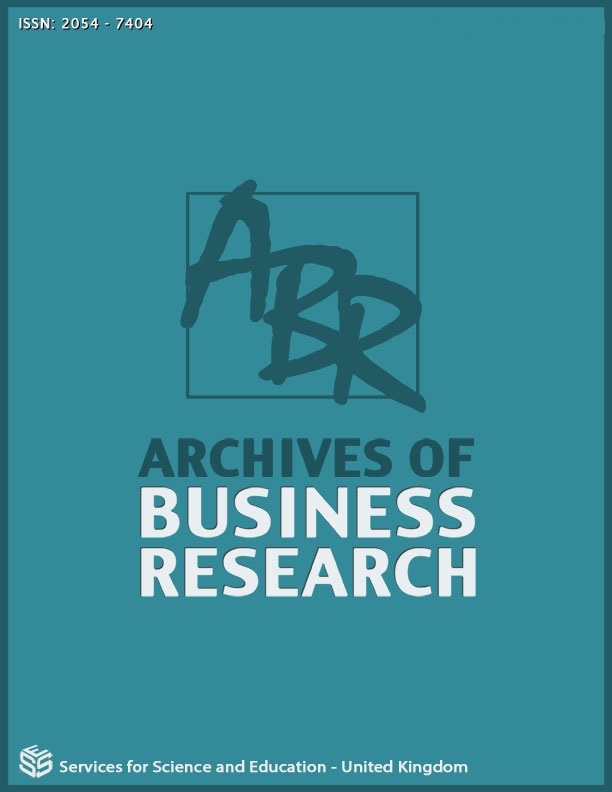Leadership and Innovation in Public Sector Organizations: A Case-Study of the Emirate of Dubai
DOI:
https://doi.org/10.14738/abr.1011.13347Keywords:
Leadership, Innovation, Public-sector, Culture, DubaiAbstract
This qualitative study is based on extensive interviews from government and semi-governments organization in the Emirate of Dubai. The study found a strong relationship between leadership and innovation in public-sector organizations of Dubai. Creation of innovation culture has a positive impact on organizational performance as well.
References
- Büschgens, T., ,Bausch,, A. and ,Balkin, D.B., 2013. Organizational Culture and Innovation: A Meta-Analytic Review†. Journal of Product Innovation Management, Vol. 30, No. 4, pp. 763-781.
- Chen, Z., Li, Y., Wu, Y., 2017. The transition from traditional banking to mobile internet finance: an organizational innovation perspective - a comparative study of Citibank and ICBC. Finance Innovation, Vol. 3, No. 12, PP.1-16.
- De Liso, N. and Vergori, A. S., 2017. The Different Approaches to the Study of Innovation in
Services in Europe and the USA. Metroeconomica, Vol. 68, No. 1, PP. 121-146.
- Ismail, W.K. and Abdmajid, R., 2007. Framework of the culture of innovation: A revisit. PP. 38-49.
- Jaskyte, K. and 2004. Transformational leadership, organizational culture, and innovativeness in nonprofit organizations. Nonprofit Management and Leadership, Vol.15, No. 2, pp. 153-168
- Lesáková Ľ., Gundová P., Kráľ P. and Ondrušová A., 2017. Innovation Leaders, Modest Innovators and Non-innovative SMEs in Slovakia: Key Factors and Barriers of Innovation Activity. Organizacija, Vol.50, No. 4, PP. 325-338. https://doi.org/10.1515/orga-2017-0024
- Lin, H. E., McDonough III, E. F., Lin, S. J. and Lin, C. Y. Y., 2013. Managing theexploitation/exploration paradox: The role of a learning capability and innovation ambidexterity. Journal of Product Innovation Management, Vol. 30, No. 2, PP. 262-278.
Lincoln, Y. S. and Denzin, N. K. (Eds.), 2003. Turning points in qualitative research: Tying knots in a handkerchief. Rowman Altamira.
Linneberg, M. S. and Steffen, K., 2019. Coding qualitative data: a synthesis guiding the novice. Qualitative Research Journal, Vol. 19 No. 3, pp. 259-270. https://doi.org/10.1108/QRJ-12-2018-0012
McCusker, K. and Gunaydin, S., 2015. Research using qualitative, quantitative or mixed methods and choice based on the research. Perfusion, Vol. 30, No. 7, pp. 537-542.
Pless, N. M., Maak, T. and Stahl, G. K., 2011.Developing responsible global leaders through international service learning programs: The Ulysses experience. Academy of Management Learning & Education, Vol.10, No. 2, pp. 237-260.
Pohl, O., 2004, Dubai keeps superlatives coming. International Herald Tribune. June 28, 2004.
Uhl-Bien, M., Marion, R. and McKelvey, B., 2008. Complexity leadership theory. Complexity
leadership, Vol.1, pp. 185-224.
Van Wart, M., 2014. Dynamics of leadership in public service: Theory and practice.2nd Edition.
New York, USA, Routledge.
Walker, R.M., Damanpour, F., Devece, C.A., 2010. Management Innovation and Organizational Performance: The Mediating Effect of Performance Management. Journal of Public Administration Research and Theory, 21, 367–386.
Walker, R. M., Brewer, G. A., Boyne, G. A. and Avellaneda, C. N., 2011. Market orientation and public service performance: New public management gone mad? Public Administration Review, Vol.71, No. 5, pp. 707–717. https://doi.org/10.1111/j.1540-6210.2011.02410.x.
Wang, Z., Zhang, M., Sun, H. and Zhu, G.., 2016. Effects of standardization and innovation on mass customization: An empirical investigation. Technovation. Vol.48, pp. 79-8
Downloads
Published
How to Cite
Issue
Section
License
Copyright (c) 2022 M. Anaam Hashmi, Sabah Al Maazmi

This work is licensed under a Creative Commons Attribution 4.0 International License.






